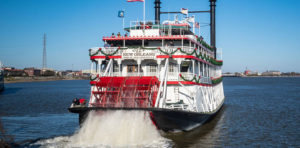
Notwithstanding the COVID-19 pandemic, dozens of masked passengers lined the gangway of City of New Orleans on a clear January afternoon. The 189-foot, diesel-electric paddlewheeler is the second vessel in the New Orleans Steamboat Company fleet, joining the 265-foot steamboat Natchez in September.
With all of the passengers aboard, pilot Troy Delaney blasted the ship’s horn. Capt. Charles Ladner, armed with a megaphone, walked to the port bridge wing and proceeded to call out speed and direction commands to Delaney. After leaving the dock, the pilot pointed the paddlewheeler downstream toward the big bend cupping Algiers Point on the Mississippi River.
City of New Orleans began life as the casino boat Casino Rock Island, built by Leevac Shipyards of Jennings, La., for the Jumer family of Peoria, Ill., in 1991. A three-year renovation of the vessel was completed in 2020.
The Jumers also ordered and operated Spirit of Peoria, designed by Capt. Alan Bates, who also designed Natchez. For Casino Rock Island, Rodney Lay of Lay, Pitman and Associates designed an enlarged version of Spirit of Peoria, with more indoor room for gaming machines.
“So vicariously, through his work on Spirit, Capt. Bates helped design Casino Rock Island,” said Matthew Dow, project manager for the restoration of City of New Orleans.
Dow follows in the riverboat footsteps of grandfather Wilbur and father Bill, who founded New Orleans Steamboat in 1972. As the company looked to grow, it sought a companion to Natchez that reflected the operator’s tradition and market, but with a level of hospitality suited to moderately sized private parties.
“City is the perfect vessel to supplement the operations of Natchez, not only due to her size, layout and amount of indoor space, but also because she is a true paddlewheel-driven vessel with the accoutrements of an old Western Rivers-style sternwheel steamboat,” Dow said. In another nod to riverboat tradition, there is a calliope on the aft upper deck.
City of New Orleans features four decks, including a rooftop viewing deck, and it is outfitted with a full bar, ADA-compliant elevator, live band and full galley. During the time of COVID, lunch, brunch and dinner options are limited.
The renovation was executed with a high level of traditional craftsmanship, but it included many modern details. The engine order telegraph, the only piece of navigation equipment remaining from the boat’s casino days, is configured to electronically signal the control units connected to the electric motors that drive the paddlewheel (slow ahead, slow astern, etc.). The diesel-electric propulsion system was designed by Norm Rittenhouse.
Nearing the dock on the return approach, Ladner took the port bridge wing with the megaphone and directed Delaney, who was operating the sticks, telegraph and thrusters. Delaney soon clicked the telegraph to full stop and explained, “I’m eliminating the wheel wash to let the wind glide us into the slip.”
As the passengers disembarked, happy for their outing in the time of COVID, Delaney wrote in the log and prepared the pilothouse for the evening dinner cruise. •

